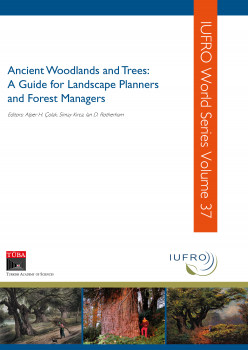Old growth and dead wood as key factors for nature conservation in managed forests. Basics and practice

Old growth and dead wood as key factors for nature conservation in managed forests. Basics and practice
Globally, forest biodiversity conservation is concentrated on the halting of primary forest harvesting and degradation by enlarging the area of undisturbed natural forest ecosystems in protected areas (FAO, 2011). At present, the Convention on Biological Diversity (CBD) aims at incorporating at least 17% of the terrestrial surface worldwide – including the most representative forest biomes – into a network of protected areas (Convention on Biological Diversity, 2010). In Europe however, forests have been shaped by humans for centuries and in most regions almost no remnants of primary forests remain. Consequently, the form and intensity of forest management is – in addition to other parameters – one of the prime factors threatening the conservation of forest habitats and species in Europe (Brunet et al., 2010). At the same time, certain traditional forest management practices, e.g. woodland grazing or coppicing, have created structurally rich forest stands, which could also be very valuable for biodiversity conservation and the provisioning of forest ecosystem services (Gross and Konold, 2010; Plieninger et al., 2011).
In this context, setting aside semi-natural forests in strictly protected areas to allow for natural dynamics in forest development is only one measure to conserve forest biodiversity in Europe. Protected areas should be complemented by other approaches, which focus on the incorporation of biodiversity requirements into forest management (Bauhus et al., 2009; Schaich and Konold, 2012), on the reestablishment or mimicking of traditional forest management systems (Rotherham, 2013; Suchomel et al., 2013), and on the restoration of structural complexity and site-adapted species in nonnatural secondary forests like conifer plantations (Zerbe, 2002). In Germany, the goals of the CBD have been taken up in the federal government’s National Strategy on Biological Diversity (BMU, 2007). It aims to protect 5% of the total forest area in strict protected areas, but also strives to foster an ambitious guideline strategy for closeto- nature forest management in public forests, to revive traditional forest management systems and to implement payment schemes for nature conservation management in 10% of the privately owned forests by 2020. Close-to-nature approaches to forest management emerged in European public forests in the second half of the twentieth century as a response to the ecological and economic problems created by the prevailing evenaged, pure and relatively young forest stands (Schütz, 1999). Close-to-nature forestry generally comprises management approaches to enhance continuous forest cover, stands with site-adapted and mixed tree species, uneven-aged stand structures, selective harvesting and the use of natural tree regeneration (Larsen and Nielsen, 2007). Beyond classical close-to-nature management approaches, further objectives of nature conservation have to be considered if managed forests are to host a high level of biodiversity and provide a broad array of ecosystem services. Such additional objectives are the conservation of largely undissected forest areas on ancient woodland sites, the avoidance of mechanical disturbance and chemical pollution of forest soils, the development of ecologically valuable forest edges, the enhancement of more open forest stands and traditional forest management practices, the augmentation of late successional phases and old growth features, and the fostering of a semi-natural amount of dead wood (Schaich and Konold, 2005).
In fact, one of the most pressing problems for forest biodiversity conservation in managed forests is the scarcity of late successional phases and old growth as well as the lack of dead wood in the form of coarse woody debris and snags (Lindenmayer et al., 2006; Nilsson et al., 2003). In primary forests, very old trees and dead wood have been ubiquitous (Keddy and Drummond, 1996). Although amounts of old growth and dead wood vary constantly according to the successional phase of forest development, there has hardly been a primary forest without old trees and dead wood (Nilsson et al., 2003). In managed forests, trees are harvested as long as they can be sold as valuable timber, which is long before they develop structures of maturity, such as dead branches in the crown or wood decay or others. In times of rising energy prices worldwide, timber of minimal quality as well as wood and branches of small dimensions are increasingly extracted from managed forests for the bioenergy sector in Europe (Plieninger et al., 2009). Old growth and dead wood offer a larger spectrum of habitats such as stem holes, wood in varying degrees of decay, as well as dead branches in the crown or bark hollows (Photograph 1). As such, a huge number of species depend on these resources, for instance hollownesting birds or saproxylic beetles (Müller et al., 2007), but also mammals like bats or dormice, amphibians, fungi and mosses (Chambers, 2002; Raabe et al., 2010). Many of the species that are dependent on old growth and dead wood structures are legally protected via Annex II and Annex IV of the EU Habitats-Directive or national laws. As a consequence, many researchers have been working on threshold values, which have to be considered in order to conserve dead wood dependent species guilds in managed forests located in different biogeographic regions (Keddy and Drummond, 1996; Lonsdale et al., 2008; Müller and Bütler, 2010). However, over the past years the amount of old growth and dead wood resources has only been marginally affected by close-to-nature management approaches (Schaich and Plieninger, 2013). As a consequence, managed forests in Germany often do not fully comply with the demands concerning structural complexity that are formulated in the German and European Union biodiversity strategies (BMU, 2007; European Commission, 2011). New practical guidelines and incentives, particularly for the enhancement of old growth and dead wood resources in public and private forests, are therefore needed. Building on empirical evidence from research projects and on a strategy for practical forest management, this chapter aims to enhance knowledge on basic interactions between old growth features, dead wood, forest management, and forest biodiversity as well as to explore practical approaches to foster such habitat resources in managed forest ecosystems. Taking the regional perspective of southwestern Germany (federal state of Baden-Württemberg), the chapter presents: basic attributes by which to classify old growth and dead wood features in forest ecosystems; outlines the actual status of regional old growth and dead wood resources in Baden- Württemberg in relation to spatial and institutional aspects; highlights the role of traditional forest uses such as woodland pasturing for the conservation of old growth features; analyses the importance of habitat trees for biodiversity and especially hollow-nesting birds; and introduces an operational strategy to foster the quantitym and quality of habitat trees and dead wood in managed state-owned forests. In a brief synthesis, we derive practical and policy recommendations on how to foster old growth and dead wood features in complex, humanshaped forest landscapes and how to synchronize this important issue with other goals of ecosystem services provisioning in European forests.
